AF Squadron Organization – And Why You Care

Now that we’ve covered your career progression, both as an officer and as a pilot, we have some context for looking at how an Air Force flying squadron is organized. Although it’d be nice to just show up to work every day and have a jet ready for you to fly, there’s a lot of behind-the-scenes action involved in keeping you trained, scheduled, and otherwise ready to go. By understanding each of the pieces in that puzzle, you can maximize your opportunities for flying, career progression, and overall quality of life.
You don’t need this article to figure out everything we’re about to tell you. If you spend enough time in a squadron, you’ll pick up on all of this eventually. However, brand new wingmen and copilots have a reputation for being ignorant lumps that generate a lot of work for people who already have plenty on their plates. I hope that by reading this you can get a head start on your education as a pilot. I hope that this will at least do a little to prevent you from deserving your new kid reputation. I hope that giving you this education now will also make life a little easier for my brothers and sisters who will have to deal with you.
Table of Contents
The Chain of Command
The primary chain of command in an Air Force flying squadron is relatively simple. Here’s a very basic diagram to illustrate:
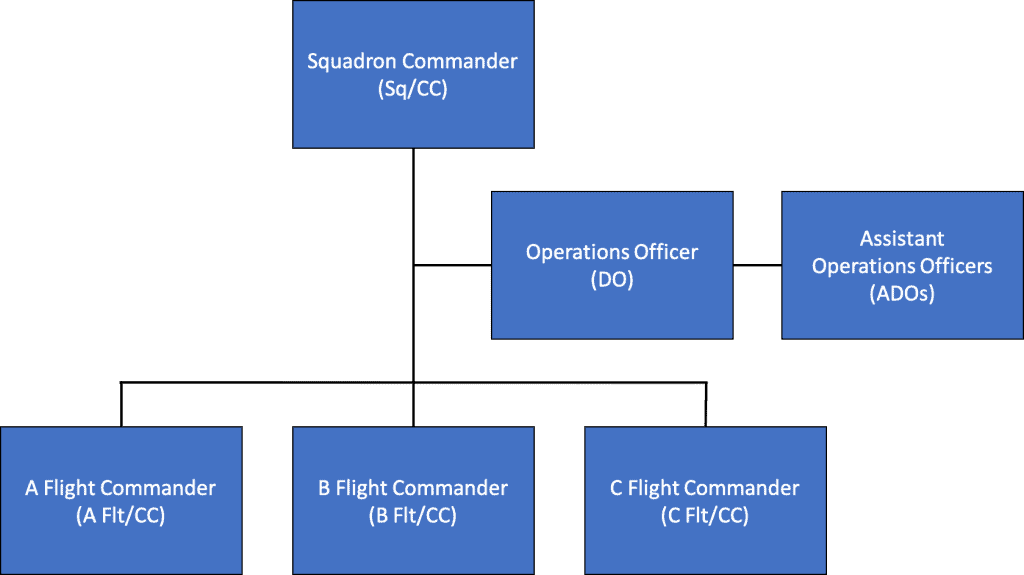
The Squadron Commander (Sq/CC) is in charge. He or she has a deputy, referred to as the Operations Officer (DO). One way to look at the difference in their roles is to say that the Commander is primarily in charge of people (orders, promotions, mentorship, etc.) while the DO is in charge of flying operations (scheduling, training, operations/maintenance relationship, etc.) (As a side note, you may be tempted to think that DO stands for “Director of Operations.” One of my DOs once told me that nothing in the Air Force gets a “Director” below the Group level. Remember this when you’re referring to your DO.)
The DO usually has at least a couple of Assistant Operations Officers (ADOs) who aren’t really in charge of anything. Their job is to do all the work that the CC and DO want to avoid. They attend meetings, they work on boring projects like preparing for inspections, they may be assigned to assist (micromanage) people who aren’t getting their work done on time. Although an ADO isn’t directly in anyone’s chain of command, he or she is probably a Major (+/- one rank) and has easier access to the DO and CC than you do. If an ADO asks you to do something, it’s in your best interest to hop to it.
By default, most squadrons seem to have three flights, though you shouldn’t be surprised to see more. My first squadron had three main flights: A, B, and C. However, it had a 4th flight just for new people to hang around in for their first year or so. It was Egg Flight…because we were baby Thunderbirds.
My smallest squadron had 18 pilots, with six in each flight. (It was a rare and unique situation.) I’d say a more average flying squadron size is 50-100. After you account for a couple levels of leadership, this usually means 3-4 flights of 10-20 people each. The biggest flying squadron I’ve ever heard of was an AC-130U squadron at Hurlburt Field, FL. Each aircraft has a crew of a dozen or more including pilots, load masters, gunners, a fire control officer, etc. the squadron was a behemoth with several hundred people.
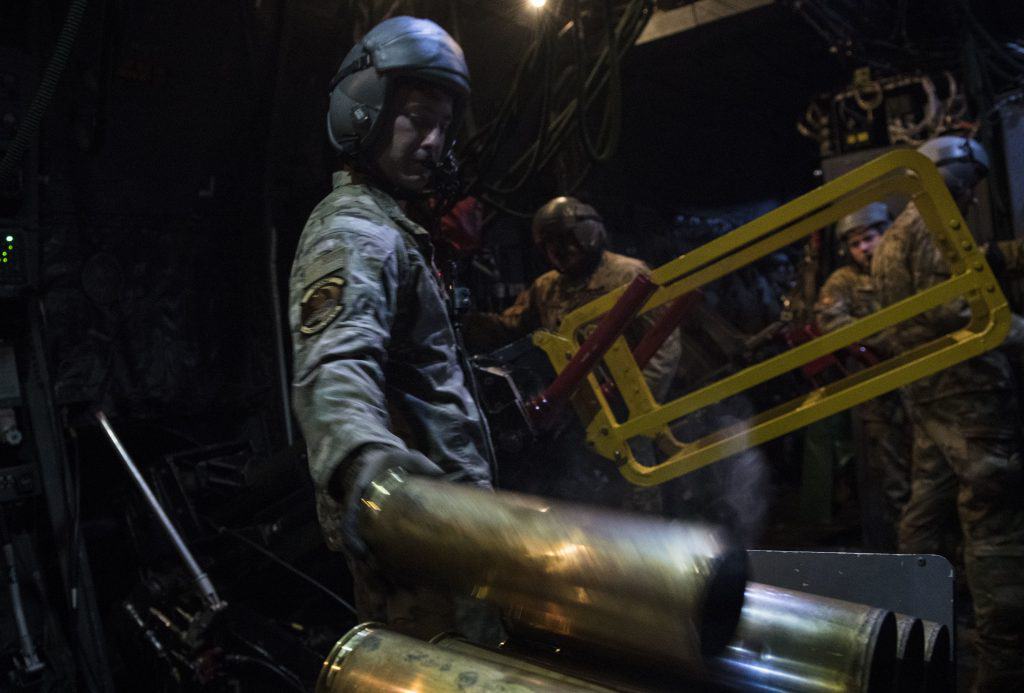
My U-28 squadrons both had five flights. Our deployment schedule was so busy that 40% of our squadron was deployed at all times. We had one flight leave on deployment and one flight return every month. This schedule has since changed, which is probably good.
Most UPT squadrons divide students among six flights. They’ve had the same name for decades, and you’ll earn a bit of instant camaraderie later on in life when you meet someone who went through the same flight as you.
Although, as we discussed earlier, you’ll eventually get assigned to work for a Shop Chief, your Flight Commander (Flt/CC) is the link above you in the chain of command. He or she is supposed to know about you and your family. If you have a problem or concern, you go to your Flt/CC. He or she is responsible for writing your performance report each year, and advocating for you to upgrade when the time comes.
You don’t want to be a source of nothing but problems and extra work for your Flight Commander, but you should interact with him or her regularly. As a very new 2Lt in the squadron, these interactions will feel a little more formal. However, once you promote to 1Lt, you’re Combat Mission Ready, and you’ve proven your value as a pilot, this relationship should start to feel more relaxed.
Being part of a tight-knit Flight is fantastic. I’ve belonged to Flights where eating lunch together was commonplace. At Laughlin, where the city of Del Rio, Texas has little redeeming value, we had made a habit of having Dragons D-Team dinner once a week. I’ve also been part of Flights where we did extra pre-deployment training and then went on the road together. A good Flt/CC has a lot of power to help facilitate this kind of environment. If you ever find yourself in that position, drive it like you stole it!
Although I’m a big fan of Flight members being close, there’s no need to exclude others for your Flight’s benefit. A lunch push can still benefit your Flight, even if the overall situation is more of: A Flight is sponsoring a lunch push for anyone interested. Although D-Team dinner was always primarily for Dragons’ flight, we always welcomed anyone from the squadron who wanted to attend.
Since your Flt/CC is both your rater and your advocate with the Sq/CC, you want him or her to appreciate you as a contributing member of the unit. He or she should be grateful to hear that you study hard, you fly well, you pay attention to your currencies (more on that shortly), and that you’re working well in your shop. If you’re failing on any of these counts, your Flt/CC will probably be the one to tell you about it. Accept that feedback humbly. If you need extra help in one of these areas, your Flt/CC will happily do whatever it takes to get you what you need.
Functional Areas (Shops)
While the main chain of command in a flying squadron is pretty simple, the rest of a squadron’s organization is actually much more involved. It takes a lot of support to keep aircraft and crews in the sky. That support structure is organized by functional areas, frequently referred to as “shops” in the Air Force. Each shop has a Chief and some workers. Each of them, the Chief and the minions, is also assigned to a Flight in the squadron. The Chief has authority to assign work to his or her people, but the Flight Commander is the one who “owns” them.
In most cases, the Shop Chiefs report to the DO, though some squadrons work things differently. On an oversimplified level, here’s how this side of a squadron’s organization looks:
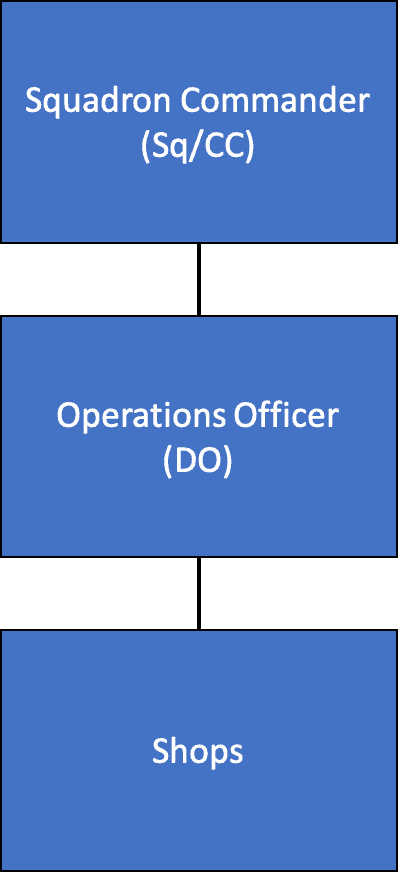
We’re going to look at what each shop does for you, and how you can tailor your interactions with them to maximize your experience in the squadron.
Admin/Execs
One of the first shops you work with in a new squadron is the Administrative section. Some Sq/CCs have a civilian secretary who answers phones, manages the appointment schedule, and frequently even has access to the Commander’s email account.
Since this secretary is usually a civilian, you’ll be tempted to treat him or her like your subordinate. Don’t make that mistake! In my experience, most of these people take their jobs seriously and have the Squadron Commander’s ear. Be patient, and polite. Ask, don’t demand or inform. Use “Sir” or “Ma’am” even though this person isn’t an officer.
This shop will also include at least one Executive Officer. The Exec’s job is to do all the other menial tasks that the Squadron Commander is too busy to deal with. They’ll manage your annual Officer Performance Report (OPR), your Promotion Recommendation Form (PRF) when the time comes, any updates to your records when you upgrade, quarterly and annual awards you want to win, and much more.
Being an Exec is generally a thankless job. There’s always a pile of work to do, but since it’s the kind of stuff that most people don’t enjoy, they rarely feel the need to thank you for doing any of it for them. Most pilots are lazy about keeping a record of what they’ve done, so putting together an OPR or PRF is always like pulling teeth. The individual pilot isn’t too worried about that OPR being late…because it has to get done eventually, right? However, the Exec’s job performance is based on his or her ability to get things done on time.

If you want to make the Exec’s life better, you should keep copious records of everything you do all year. If the Exec or your Flight Commander ask for inputs for an OPR or quarterly award, you should be able to provide a bunch of great data right away.
Exec is a job for people in the 1Lt to young Captain range, meaning they’ll be your peers pretty quickly. You probably want to help them out because they’re your buddies. However, it’s also important to realize that the Execs have a lot of input on what goes into your OPR, PRF, awards, etc. If you’re the kind of person who always works hard to give them good data, they’ll work hard to make sure you get the best performance report possible. If you’re the person always causing them problems, they’re not going to put as much effort into polishing your paperwork.
Realize that these officers also have unique access to your Commander. He or she will occasionally ask them to nominate people for awards or upgrades. Your helpfulness vs painfulness will factor in these recommendations as well.
Some squadrons also have an Awards and Decorations Shop within the administrative section of the squadron. This shop deals with quarterly awards, the Air Medals you get for flying combat missions, and more. This is another shop that you should be interested in getting good data as soon as they ask for it. It’s in your own best interest.
Training
It’s likely that the next shop you’ll interact with in a new squadron is Training. This shop is responsible for running Mission Qualification Training (MQT), upgrade training, etc. As an Air Force pilot, you’re also responsible for maintaining a variety of currencies. You have to get a certain number of landings and instrument approaches every so many days. You have to complete at least one flight in each of your aircraft’s mission sets every so often. Training is partially responsible for monitoring all those currencies and helping to get you scheduled for something if you’re coming due.
This shop is also in charge of managing currencies for a variety of ground training tasks from Fire Extinguisher Safety, to Sexual Assault Awareness and Prevention, to Chemical Warfare training. They have to report everyone’s completion status, but it’s your job to make sure you know when something is due and get scheduled for it. You’ll have to ask a Scheduler to contact the appropriate office and make your appointment in many cases, but it’s still your responsibility to make it happen. If you go non-current for a ground training item, the schedulers will get yelled at even though you’re also at fault.
Training owns the squadron’s Instructor Pilots, and those are a precious resource. They won’t tolerate you causing a lot of problems. You need to make sure you’re ready for any given training event. If you have an appointment that will prevent you from being available for training, you need to make sure they know about it right away! If the appointment is a mandatory military thing, then you’re informing the Training Shop. However, if it’s something personal or optional, you are asking rather than informing.
You’ll probably want to upgrade rapidly and maintain all of your currency items; however, you should be careful about addressing the scheduling of these events with the Training Shop. They have a lot of training to accomplish, and a limited set of resources. If you’re constantly bugging them about what you need, they’ll get annoyed and you might find yourself scheduled for next month instead of this month.
Make sure that you spend the majority of your time being great at what you do. Study hard, spend extra time in the simulator, and fly well in the jet. You also need to be a good worker in whatever shop job you’re assigned. If you can do a good job with all of that, the IPs in Training Shop will notice and they’ll push you into training as soon as they can.
One other way the Training Shop can make a difference is in helping make sure you get chosen for Advanced Instrument School, Safety School, and some of the other less-common training opportunities that we mentioned in our article on Pilot Career Progression. You shouldn’t badger these people about these opportunities. However, once you’ve proven to the squadron at large that you’re a hardworking, contributing member of the team, it’s important that both your Flight Commander and the Chief of Training know if you’re interested in attending one of these courses. Continue to be the pilot who doesn’t cause any headaches for the Training Shop and they’ll remember you when word comes down that a training slot is available.
Weapons and/or Tactics
In many squadrons, the Weapons and Tactics Shop deals with the flashy, exciting stuff where most young pilots want to focus most of their time and energy. This is okay. As a young aviator, spend lots of time studying in the classified vault that the Weapons Officers manage.
(Note: when I say weapons here I mean tactical employment of aircraft, and not going to the range to shoot your M-9. However, there are Weapons Officers in many communities you might not expect these days. The USAF Weapons School has students from tankers, drones, and the U-2, along with the fighter and bomber pilots you’d expect. If you don’t know what a Weapons Officer could have to say about flying the KC-135, then you definitely need to introduce yourself and have a chat.)
It’s probably a good idea to ask questions or engage your Weapons Officers in discussions, but only for graduate-level stuff after you’ve learned the basics on your own. The Weapons Officers are busy and don’t have much tolerance for lazy or stupid questions.
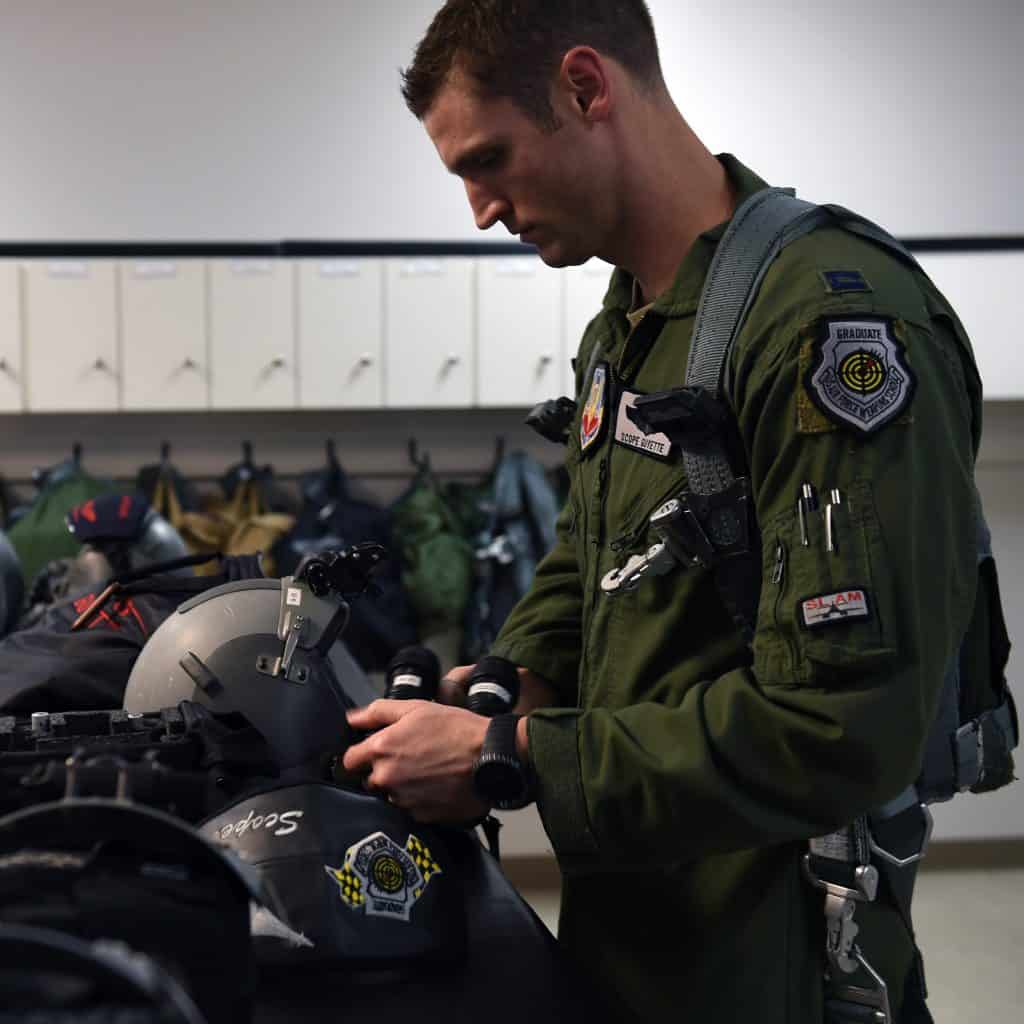
Your first interactions with your Weapons Officers can have a significant impact on your reputation within the squadron. If you show up unfocused and lazy, that will stick with you for a long time and cause you problems later. If you show up working hard from the moment you get there, and prove that you’re capable of figuring out a lot of things on your own, then some of the most respected pilots in the squadron will feel confident in recommending that you upgrade ahead of your peers. You definitely want to impress these people, without overdoing things.
Scheduling
Sometimes called Current Operations, the Scheduling Shop manages the daily flying schedule for your squadron. As a pilot, you want to fly, so you should do whatever is in your power to keep the schedulers happy.
Many Scheduling Shops have a large wall of computer screens or whiteboards where they manipulate the weekly schedule. Unless you are assigned to work in this shop, you should never, ever tough those walls! I’ve even been in squadrons where non-schedulers were forbidden from even entering the office.
Scheduling is a busy and thankless job. If everything goes perfectly, nobody ever notices or thanks the scheduler. However, the minute something goes wrong, everybody is angry at them. How can things go wrong? Weather, maintenance, airspace closures, and pilots being unable to fly. Of those, you can only control one thing, so don’t screw it up! If you’re sick, you should not fly. However, the more time you can give a scheduler to deal with a given issue, the better. Don’t be that pilot who starts trying to get a hold of a scheduler at 4:00 am for a 5:00 am showtime. If you don’t feel well, let them know the day before. I promise, you’re far better off from a personal and a scheduling standpoint if you make that decision early.
Even if every pilot in the Air Force read and obeyed the advice in that last paragraph, things will still happen. Traffic on the way to work, a kid gets sick in the middle of the night, an evening out that wasn’t supposed to get out of hand. When the schedule breaks, you can become a Scheduler’s favorite person by being ready to step in at the last minute and fly. It’s not uncommon to hear an announcement in the squadron to the effect of: “Any available wingman/copilot report to the step desk now!” That’s a good deal for you, so run!
Scheduling shares responsibility with Training to make sure that every pilot in the squadron remains up-to-date on all recurrent training requirements. They shouldn’t need a great deal of direct input from you to manage this. However, if you notice that you’re coming due for something, you do need to let a Scheduler know. A polite, tactful reminder will ensure that your currency item hasn’t been overlooked and gets on the schedule ASAP.
If you’re the type of pilot who habitually makes these notifications early enough that it’s easy for Scheduling to address the issue, they’ll appreciate you. If you’re always the person scrambling at the last minute because you played “I have a secret!” they’ll remember that too. Flying squadrons are very small places, and someone who causes the Schedulers grief will find it’s an uphill battle to get chosen for upgrades and other good deals.
Aviation Resource Management (ARMS)
A flying squadron has to keep records of every flight, and this job belongs to the enlisted personnel to administer the Aviation Resource Management System (ARMS).
Each time you step to fly, an ARMS troop will check the computer system to verify your currencies. After your flight, you’ll fill out a flight record accounting for your hours, landings, and any currency items you completed. This is not a process to take lightly, as this system is the Air Force’s official record of your flight experience. The Training, Scheduling, and Mobility shops rely heavily on the data that the ARMS Shop collects and maintains.
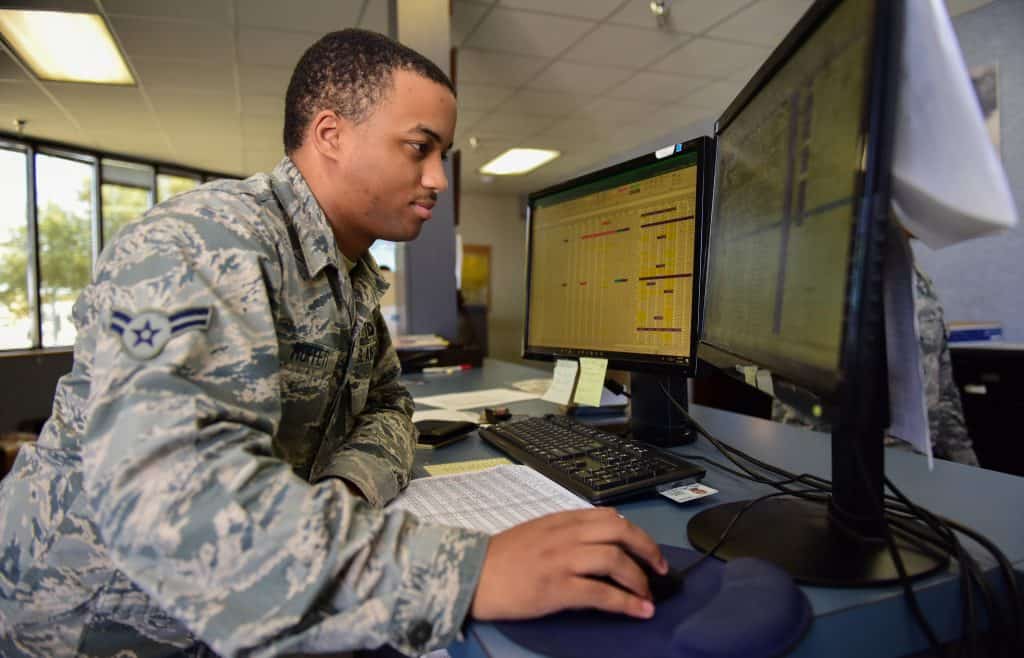
Many flying squadrons are comprised almost completely of officers; however, even a squadron of single-seat fighter pilots will have at least a few enlisted ARMS troops to fill this function. Depending on your background, this could provide your first interaction with enlisted personnel. Treat them with respect and patience. They get paid almost nothing, they work long hours, they go to work every day in an office while they watch a constant stream of pilots go fly the world’s most amazing aircraft…and they have complete control over your flight records.
I’ve always enjoyed working with ARMS troops. They’re motivated and professional. However, I never quite felt safe trusting the entirety of my Air Force flight records to an underpaid 19-year-old. I always took the ARMS products and backed them up in a personal logbook. If you’re looking for a really easy way to do this, I recommend MilKEEP. It’s a company founded by a C-17 pilot and his wife. They’re using advanced technology to make it painless to backup your military flight records, and convert your logbook to civilian hours in case you need it for a future job.
Aircrew Flight Equipment (AFE)
The other place that any Air Force pilot is likely to deal with enlisted personnel is the in Aircrew Flight Equipment or AFE Shop. These are the people who take care of your helmet, harness, NVGs, survival gear, and other equipment – meaning they literally have your life in their hands. As an aspiring pilot, you may not realize that each piece of that equipment will need adjusting from time to time. In my experience, AFE troops tend to enjoy their job and are always motivated, even excited, to help you fix an issue.

You’re always better off checking your equipment at least one day before you’re scheduled to fly. If there’s an issue, that gives AFE time to make adjustments. The worst thing you can do for your AFE troops is to show up, half-dressed to go fly, and say, “Something’s wrong with my mask. I need it fixed now!”
In my experience, they’ll jump to take care of you in this situation. However, sometimes fixes take a while. Everyone in your crew/flight will be waiting for you, and know that you’re the jerk making everyone’s favorite AFE troops jump through hoops. Don’t be that pilot!
The ARMS shops are overseen by a Senior Non-Commissioned Officer and doesn’t have an officer in the chain of command until well above your squadron’s level. However, the AFE Shop is usually under the care of a Flight Commander assigned to the base’s Operational Support Squadron (OSS). If you need a Flight Commander job for your career progression, being the AFE Flt/CC is another option you could consider. Among Air Force pilots, it’s a very unique opportunity to supervise enlisted personnel at a relatively young rank. You’ll learn lessons there that many pilots won’t pick up on for years, and it will reflect well on your record.
Standardization/Evaluation
The Stan/Eval Shop is unique in that the DO doesn’t officially own it. This shop reports directly to the Squadron Commander.
The Stan/Eval Shop has two main functions. The first is making sure that all the manuals and regulations being used in the squadron are up-to-date. This is an enormous task that can occupy several minions full-time. The second function of the Stan/Eval shop is managing pilot checkrides. This shop owns all the Evaluator Pilots in the squadron and works with the Training and Scheduling shops to cover both your recurring checkrides and any checkrides associated with the completion of an upgrade program.
The Stan/Eval shop also tracks statistics about overall pilot performance on those checkrides for the Commander. Ideally, these help squadron leadership notice trends from high or low pilot performance, to training programs not meeting their goals, to policies or procedures that are being overlooked or ignored.
Your primary interaction with this shop will be flying your checkrides. That’s always a little scary, but remember that your EP doesn’t like giving checkrides any more than you like getting them.
If you have a question, the Stan/Eval Shop is a good place to go for an authoritative answer. They may not be Weapons Officers, but an Evaluator Pilot should have enough knowledge to address any question you have. Don’t show up asking lazy questions though. When I worked in Stan/Eval, my first response to any question was, “What do the regs say about that?”
In the cases that made me happy, the person asking the question could show me what he or she had researched and bookmarked before getting stumped. However, in most cases the answer seeker would reply with a blank stare. I’d then say, “Well, let’s look it up together.”
I’d spend the next few minutes getting a very good feel for how familiar the other pilot was with the applicable publications. I was always glad to take as long as necessary to answer the question at hand. However, you can be sure that I noticed the pilots who seemed poorly-versed in the material they were supposed to know. Evaluator Pilot opinions carry a lot of weight in discussions on who should be chosen for the next upgrade, a desirable Shop Chief job, or even Flight Commander jobs. Repeatedly making yourself look lazy for the Stan/Eval shop is a good way to not get picked for these good deals.
Mobility
The Mobility Shop is responsible for making sure that every member of the squadron is ready to deploy on time. The main part of their job is managing a folder of all the documents that prove deployment readiness. Most of these items are required flight or ground events that the Training Shop is tracking anyway. However, there are some other things like being up-to-date on shots and other medical appointments that only Mobility tracks.
You should periodically check on your Mobility Folder to see if you’re coming due for something. If you are, get it done without being prompted! This will be viewed very favorably by the Mobility Shop, and will contribute to your good reputation in the squadron.
If you’re the pilot whom the Mobility Shop is always having to hound to get things done, and you’re always finishing at the last moment, or even late, they’ll notice. You’re not going to get picked to be a Flight Commander or Shop Chief in charge of other people if you can’t manage your own readiness. And yes, your Squadron Commander and DO talk to the Chief of Mobility about this on a regular basis.

Occasionally, the Mobility Shop will come up with a good deal. Maybe someone needs to fly a couple of jets out to the desert and bring a couple of others back for maintenance. Maybe there’s a unique deployment opportunity that would be great for your career. The first step to getting chosen for these good deals is to have your Mobility Folder completely up-to-date. If you’re missing something when the tasking comes down, you may not even be considered for the good deal.
On the other side of that coin, the Mobility Shop occasionally gets tasked to provide a body for a bad-deal deployment. Want to answer phones and make coffee for Colonel Desktop in a windowless hole for 6 months? Watch out! In this case, having your Mobility Folder ready to go is a mixed blessing. The best I can say is that you need to be the kind of pilot that every Shop Chief in your squadron wants around. You want to be the person who always knows when something is coming due and gets it taken care of, early, without being prompted. I’ve found that bad-deal deployments don’t usually get assigned to people like this. There’s usually at least enough notice to send a slug to last-minute training before sending him or her out the door. The Chief of Mobility will breathe a sigh of relief to get that pilot out of the squadron for a few months. So, don’t be that person!
Plans
I didn’t realize how important and potentially valuable the Plans Shop was as a young pilot. You could also think of this shop as long-term scheduling. They’re in charge of requesting range time months in advance. They also coordinate for people from your squadron to attend exercises all over the world.
Would you like to spend a week fighting against or refueling Navy F-18s in Key West? Do you want to go to Red Flag Alaska this summer, or next year in the dead of winter? Do you want to take a jet to your hometown airshow? The Plans Shop is in charge of deciding who attends all of these events. If you want these good deals, it behooves you to make sure the people in this shop are on your side!
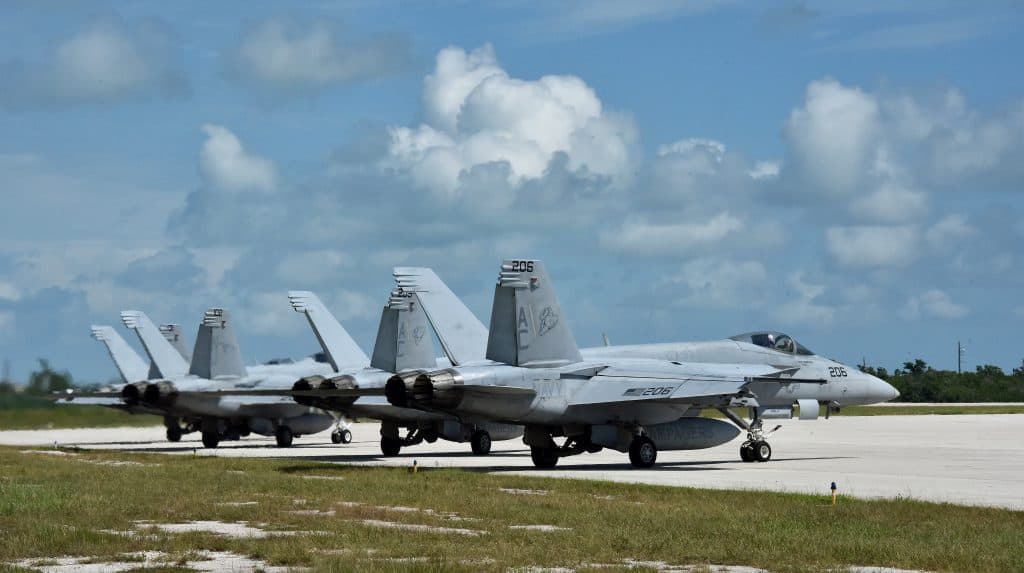
You might think that working in this shop would be the ultimate good deal. The Chief of Plans must spend every winter TDY in Hawaii, right? Unfortunately, they can’t appear to extend too much favoritism. They try to spread the love to the whole squadron, but there are all kinds of love. As long as they’re handing out equal numbers of special opportunities they can have a lot of say in which ones you get.
Unlike Training, Mobility, or Scheduling, there isn’t a whole lot you can do to make life better or worse for anyone in the Plans Shop. Your ability to get good deals here will be based on your overall competence in the squadron and your personal relationships with these people. My personal philosophy is to try and be friendly to everyone, but it doesn’t hurt to go out of your way to make sure people in the Plans Shop aren’t left out.
Safety
Ideally, the Safety Shop should be the most boring place in the world to work. They usually have a bulletin board in the squadron where they post safety-related news articles and reminders…and you’ll walk past it every day without noticing it. If that’s all this shop ever did, it’d be awesome.
However, the nature of military aviation is such that mishaps tend to occur. John Boyd argued that if we aren’t occasionally crashing airplanes we aren’t pushing ourselves hard enough. Thankfully, the majority of these mishaps will be relatively minor, and the Safety Shop’s job will be limited to helping you fill out the applicable reports. In the case of a major mishap, a fully-trained Safety Officer will take part in the accident investigation. In order to help ensure impartiality, the Air Force frequently brings in a Safety Officer from another base to help with that process. This can mean some very visible and impactful TDYs.
Any time I was bored as a Safety Officer, I tried to look at the squadron to see if there was anything we could to be both more effective and more safe. Chief of Safety is most likely an IP-level job, so it’s not inappropriate for the Safety Officer to bring these sorts of things up. Frequently, this person can coordinate with the Training, Weapons, and Stan/Eval shops to put out squadron-wide guidance.
This is a rewarding job, but not always one that a young pilot has a lot of interaction with. If you have any safety-related concerns, don’t hesitate to bring them up, tactfully, with a Safety Officer.
If you’re interested in potentially becoming a Safety Officer someday, I highly recommend expressing your desires to your Safety Officer and form a mentoring relationship with him or her. Aside from just being good at your job, the most critical part of getting chosen to attend Safety School and do this job is to express interest. Your Safety Officer will communicate your desires to your Squadron Commander along with a recommendation of whether you would be a good fit for the job. You should also express your desires to your Flight Commander. If your Squadron Commander hears about your interests from both sources, you’ll be even more likely to get the job at some point.
Squadron Summary
Each of these shops is important to the overall function of your squadron. Now that you know what each one does, I hope you can tailor and prioritize your interactions with each one. At first, you’ll be focused on in-processing with the Admin Section and Mission Qualification with the Training Shop. As you progress, you’ll spend more time studying under the care of Weapons and Tactics, you’ll start caring more about how the Scheduling Shop affects your life, and you’ll want to make sure that you have things squared-away with Mobility so that you’ll be ready to fight the war when the call comes. You’ll deal with Stan/Eval for checkrides and tough questions that you can’t answer elsewhere. The Plans Shop has the power to maximize your enjoyment of enrichment training activities like exercises. Hopefully you won’t have to deal with the Safety Shop, though if you want to pursue that career path you should spend some time with them.
Each of these shops manages some part of your flying career. Your goal should be to figure out what each one needs from you and provide a solution without having to be asked. Every time you do this, they’ll notice that you’re a sharp pilot capable of thinking ahead and working efficiently. That’s exactly the type of person your Commander wants for flying upgrades, and important jobs in the squadron. Don’t be the person that the Shop Chiefs have to chase down because you didn’t even know you had something due!
Depth and Breadth
As a young pilot in a squadron, you’ll be assigned to work in one of these shops. None of those jobs is especially complicated. You should start by reading the regulations that govern your Shop and participating in as many projects as possible to understand your Shop’s role. This will make you a more efficient member of the Shop in the short-term, but it will also help you lead more effectively as a Flight Commander and higher.
Ideally, you’ll work in more than one shop as a young aviator. If you get assigned to the Weapons and Tactics shop, it’ll be tempting to stay there forever. If you feel like you’re getting comfortable in a position, I recommend you mention as much to your Shop Chief and Flight Commander and ask if they think you should learn something new.

I have a friend who started his career as an Exec and stayed there for several years. He did a good job, and as a “reward” he was slated to move directly into Flight Command next. I suggested he ask for a detour though. On that career path, he’d be really good at writing OPRs and attending staff meetings, but he’d have no clue about how to manage a flying schedule or deploy people around the world. As tempted as you may be to “fast-track” your career if the opportunity presents itself, don’t be afraid to spend some time in a few different shops on your way up. I promise the knowledge you gain in each one will come in handy later!
There is no better environment for a pilot than a combat flying squadron. You automatically gain a bunch of new friends the moment you walk in the door. You get to spend every day hanging out with people who share the same interests as you. You’ll work alongside some of the best people our country has to offer, and you’ll be able to push each other to constantly improve yourselves. You will never get an environment like that again. Enjoy it while you’re there!
Image Credits:
This post’s feature image is a KC-135 crew: https://www.dvidshub.net/image/6114705/kc-135-stratotanker-refuels-fight-during-cope-north-20.
The shot of Col. Christopher Freeman getting a medal is from: https://www.dvidshub.net/image/4026619/414th-fg-changes-command.
The ARMS troop photo is at: https://www.dvidshub.net/image/5345513/laughlin-harm-and-sarm-award-winning-1charlies.
The shot of the AFE expert at work is from: https://www.dvidshub.net/image/5953887/aircrew-safety-top-priority-afe-shop.
The shot of the B-1 Weapons School graduate is from: https://www.dvidshub.net/image/3511166/best-best.
The AC-130 gunners lobbing 105 mm shells is from: https://www.dvidshub.net/image/6039305/4th-sos-conduct-readiness-sortie.
A stack of mobility folders: https://www.dvidshub.net/image/3287444/exercise-ag-17-5-kicks-off.
The Navy F-18s in Kew West are from: https://www.dvidshub.net/image/5825715/jets-take-off-nas-key-west.
The C-130 ramp is from MN, and the photo is here: https://www.dvidshub.net/image/6104814/waiting.







